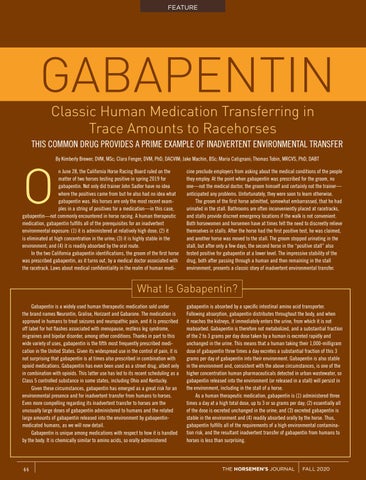FEATURE
GABAPENTIN Classic Human Medication Transferring in Trace Amounts to Racehorses
THIS COMMON DRUG PROVIDES A PRIME EXAMPLE OF INADVERTENT ENVIRONMENTAL TRANSFER
O
By Kimberly Brewer, DVM, MSc; Clara Fenger, DVM, PhD, DACVIM; Jake Machin, BSc; Maria Catignani; Thomas Tobin, MRCVS, PhD, DABT
n June 28, the California Horse Racing Board ruled on the matter of two horses testing positive in spring 2019 for gabapentin. Not only did trainer John Sadler have no idea where the positives came from but he also had no idea what gabapentin was. His horses are only the most recent examples in a string of positives for a medication—in this case, gabapentin—not commonly encountered in horse racing. A human therapeutic medication, gabapentin fulfills all of the prerequisites for an inadvertent environmental exposure: (1) it is administered at relatively high dose; (2) it is eliminated at high concentration in the urine; (3) it is highly stable in the environment; and (4) it is readily absorbed by the oral route. In the two California gabapentin identifications, the groom of the first horse was prescribed gabapentin, as it turns out, by a medical doctor associated with the racetrack. Laws about medical confidentiality in the realm of human medi-
cine preclude employers from asking about the medical conditions of the people they employ. At the point when gabapentin was prescribed for the groom, no one—not the medical doctor, the groom himself and certainly not the trainer— anticipated any problems. Unfortunately, they were soon to learn otherwise. The groom of the first horse admitted, somewhat embarrassed, that he had urinated in the stall. Bathrooms are often inconveniently placed at racetracks, and stalls provide discreet emergency locations if the walk is not convenient. Both horsewomen and horsemen have at times felt the need to discreetly relieve themselves in stalls. After the horse had the first positive test, he was claimed, and another horse was moved to the stall. The groom stopped urinating in the stall, but after only a few days, the second horse in the “positive stall” also tested positive for gabapentin at a lower level. The impressive stability of the drug, both after passing through a human and then remaining in the stall environment, presents a classic story of inadvertent environmental transfer.
What Is Gabapentin? Gabapentin is a widely used human therapeutic medication sold under the brand names Neurontin, Gralise, Horizant and Gabarone. The medication is approved in humans to treat seizures and neuropathic pain, and it is prescribed off label for hot flashes associated with menopause, restless leg syndrome, migraines and bipolar disorder, among other conditions. Thanks in part to this wide variety of uses, gabapentin is the fifth most frequently prescribed medication in the United States. Given its widespread use in the control of pain, it is not surprising that gabapentin is at times also prescribed in combination with opioid medications. Gabapentin has even been used as a street drug, albeit only in combination with opioids. This latter use has led to its recent scheduling as a Class 5 controlled substance in some states, including Ohio and Kentucky. Given these circumstances, gabapentin has emerged as a great risk for an environmental presence and for inadvertent transfer from humans to horses. Even more compelling regarding its inadvertent transfer to horses are the unusually large doses of gabapentin administered to humans and the related large amounts of gabapentin released into the environment by gabapentinmedicated humans, as we will now detail. Gabapentin is unique among medications with respect to how it is handled by the body. It is chemically similar to amino acids, so orally administered
44
gabapentin is absorbed by a specific intestinal amino acid transporter. Following absorption, gabapentin distributes throughout the body, and when it reaches the kidneys, it immediately enters the urine, from which it is not reabsorbed. Gabapentin is therefore not metabolized, and a substantial fraction of the 2 to 3 grams per day dose taken by a human is excreted rapidly and unchanged in the urine. This means that a human taking their 1,000-milligram dose of gabapentin three times a day excretes a substantial fraction of this 3 grams per day of gabapentin into their environment. Gabapentin is also stable in the environment and, consistent with the above circumstances, is one of the higher concentration human pharmaceuticals detected in urban wastewater, so gabapentin released into the environment (or released in a stall) will persist in the environment, including in the stall of a horse. As a human therapeutic medication, gabapentin is (1) administered three times a day at a high total dose, up to 3 or so grams per day; (2) essentially all of the dose is excreted unchanged in the urine; and (3) excreted gabapentin is stable in the environment and (4) readily absorbed orally by the horse. Thus, gabapentin fulfills all of the requirements of a high environmental contamination risk, and the resultant inadvertent transfer of gabapentin from humans to horses is less than surprising.
THE HORSEMEN’S JOURNAL
FALL 2020
